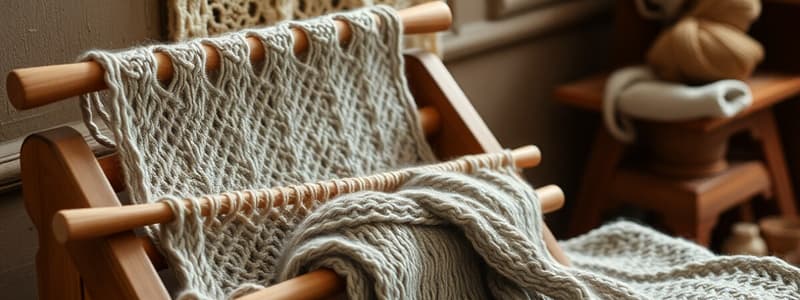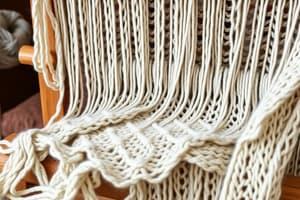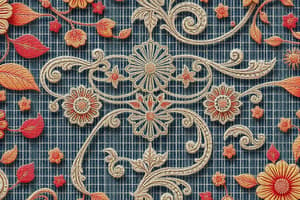Podcast
Questions and Answers
Which of the following social media platforms are mentioned as having helped build online knitting communities?
Which of the following social media platforms are mentioned as having helped build online knitting communities?
- Tumblr, Reddit, Twitch
- Instagram, YouTube, Ravelry (correct)
- Facebook, Twitter, TikTok
- LinkedIn, Pinterest, Snapchat
Upcycling refers to the process of discarding old clothes instead of reusing them.
Upcycling refers to the process of discarding old clothes instead of reusing them.
False (B)
Besides a creative outlet, what is one mental health benefit associated with knitting?
Besides a creative outlet, what is one mental health benefit associated with knitting?
stress reduction
What is the commonly used Tagalog term for knitting?
What is the commonly used Tagalog term for knitting?
In Africa, the designs in knitted garments can represent the wearer's social status or ______.
In Africa, the designs in knitted garments can represent the wearer's social status or ______.
Match the cultural elements with their association with knitting:
Match the cultural elements with their association with knitting:
Knitting is believed to have originated in the 16th century
Knitting is believed to have originated in the 16th century
What invention helped industrialize the process of knitting in the 16th century?
What invention helped industrialize the process of knitting in the 16th century?
What is the concept of 'slow fashion' related to in the context of knitting?
What is the concept of 'slow fashion' related to in the context of knitting?
Knitting is considered a purely practical activity with no cultural significance.
Knitting is considered a purely practical activity with no cultural significance.
William Lee was a clergyman who is best known for inventing the ______.
William Lee was a clergyman who is best known for inventing the ______.
What was the reaction of Queen Elizabeth I to William Lee's invention?
What was the reaction of Queen Elizabeth I to William Lee's invention?
In addition to marking births and marriage, what is another reason for the ceremonial use of knitting in some Indigenous cultures?
In addition to marking births and marriage, what is another reason for the ceremonial use of knitting in some Indigenous cultures?
Match the following time periods with their significance to knitting:
Match the following time periods with their significance to knitting:
During the Victorian Era, knitting was solely a domestic craft
During the Victorian Era, knitting was solely a domestic craft
Which of the following is a publication related to knitting during the Victorian Era?
Which of the following is a publication related to knitting during the Victorian Era?
During which conflict did charitable knitting for soldiers become prominent with items like socks and blankets being sent to the front lines?
During which conflict did charitable knitting for soldiers become prominent with items like socks and blankets being sent to the front lines?
During wartime, knitting was primarily a hobby for women with no real impact on the war effort.
During wartime, knitting was primarily a hobby for women with no real impact on the war effort.
What essential items did soldiers require during wartime that could be produced by knitting?
What essential items did soldiers require during wartime that could be produced by knitting?
Organizations like the ___________ organized knitting drives to collect knitted goods for soldiers.
Organizations like the ___________ organized knitting drives to collect knitted goods for soldiers.
What did knitting during wartime symbolize for those participating?
What did knitting during wartime symbolize for those participating?
During wartime, wool for knitting was easily available for civilians without restrictions.
During wartime, wool for knitting was easily available for civilians without restrictions.
Match the following concepts related to war time knitting:
Match the following concepts related to war time knitting:
Besides practical necessities, what else did knitting provide for the women who participated in it during wartime?
Besides practical necessities, what else did knitting provide for the women who participated in it during wartime?
Flashcards
Knitting
Knitting
The process of creating fabric by looping yarn together using needles.
Origin of Knitting
Origin of Knitting
The earliest evidence of knitting dates back to the 11th century in Egypt, where knitted socks were discovered.
Stocking Frame
Stocking Frame
A machine invented by William Lee in the 16th century that revolutionized the knitting process, making knitted fabric more accessible.
Victorian Era and Knitting
Victorian Era and Knitting
Signup and view all the flashcards
Domestic Craft
Domestic Craft
Signup and view all the flashcards
Knitwear Fashion
Knitwear Fashion
Signup and view all the flashcards
Industrialization of Knitting
Industrialization of Knitting
Signup and view all the flashcards
Knitting Publications
Knitting Publications
Signup and view all the flashcards
Online Knitting Communities
Online Knitting Communities
Signup and view all the flashcards
Sustainable Knitting
Sustainable Knitting
Signup and view all the flashcards
Knitting for Mental Wellbeing
Knitting for Mental Wellbeing
Signup and view all the flashcards
Ceremonial Knitting
Ceremonial Knitting
Signup and view all the flashcards
Symbolic Knitting
Symbolic Knitting
Signup and view all the flashcards
Knitting for Religious Purposes
Knitting for Religious Purposes
Signup and view all the flashcards
Knitting and Social Status
Knitting and Social Status
Signup and view all the flashcards
Knitting and Family Heritage
Knitting and Family Heritage
Signup and view all the flashcards
Knitting's Importance in Wartime
Knitting's Importance in Wartime
Signup and view all the flashcards
Mass Civilian Participation in Knitting
Mass Civilian Participation in Knitting
Signup and view all the flashcards
Knitting as a Symbol of Support
Knitting as a Symbol of Support
Signup and view all the flashcards
Resourcefulness in Wartime Knitting
Resourcefulness in Wartime Knitting
Signup and view all the flashcards
Charitable Knitting in the Crimean War
Charitable Knitting in the Crimean War
Signup and view all the flashcards
Charitable Knitting
Charitable Knitting
Signup and view all the flashcards
Knitting as a Hobby
Knitting as a Hobby
Signup and view all the flashcards
Evolution of Knitting Practices
Evolution of Knitting Practices
Signup and view all the flashcards
Study Notes
What is Knitting?
- Knitting, in Tagalog, is sometimes called "pagbababad" or "pananahi."
- More commonly, it's referred to as "pag-aahit" or "pagkakalikat" in Tagalog.
- Knitting involves connecting threads using needles to create fabric.
- This creates items like sweaters, scarves, and other textiles.
When Did Knitting Start?
- Knitting's origins are estimated to be between the 1st and 5th centuries AD.
- Evidence suggests it started in the Middle East, specifically Egypt.
- Knitted socks from the 11th century have been discovered.
- The craft spread throughout Europe and the Mediterranean, used to create garments and decorative items.
Knitting in the 16th Century
- Knitting became more common in Europe.
- Techniques improved.
- The invention of the stocking frame (a knitting machine) in the 16th century by William Lee, an Englishman, made knitted fabric more accessible.
Victorian Era Knitting
- The Victorian Era (1837-1901) was a significant period for knitting.
- It wasn't only a household activity but also a part of the textile industry.
- Knitting became more popular due to social, cultural, and technological factors.
- Common Victorian era knitting practices:
- Domestic craft and household activity.
- Styles of knitwear affected by trends.
- Advancements in industrialization that led to more knitting machines.
- Publications like "The Lady's Self-Instructor in Knitting, Crochet, and Netting" (1847).
- Knitted items used for charity.
- Items like socks, gloves, blankets were donated and sent during war times or economic hardship
- Examples include the Crimean War (1853-1856).
Wartime Knitting
- Knitting became essential during World War I and World War II.
- Soldiers needed warm clothing like socks, gloves, scarves, and sweaters.
- Knitting drives by organizations (like the Red Cross), were organized to create large amounts of warm clothing.
- Knitting displayed patriotism and community support.
- Scarcity of materials, like wool, prioritized use by the military, but knitters adapted.
Today's Knitting
- Knitting is still a popular hobby in modern times.
- Online knitting communities and social media (like Instagram, YouTube, and Ravelry) support modern knitters.
- Sustainability and eco-friendly knitting (like upcycling) has emerged as a more recent trend.
- Knitting is associated with well-being, a way to reduce stress and improve mental health.
Symbolic and Cultural Aspects of Knitting
- Knitting plays symbolic and ritualistic roles in some cultures.
- Knitting is linked to ceremonies, rites of passage and celebrations.
- Special knitted items can carry cultural significance in the form of stories, folklore, or historical knowledge (examples include the designs in Norwegian and Swedish garments) and may represent family history or heritage.
Conclusion
- Knitting has significantly shaped cultures worldwide through cultural preservation, bonding, economic stability, and expression.
- Through clothing, it displays regional identity, and empowers individuals, especially women.
- Knitting connects individuals across generations, communities and continents.
Studying That Suits You
Use AI to generate personalized quizzes and flashcards to suit your learning preferences.





